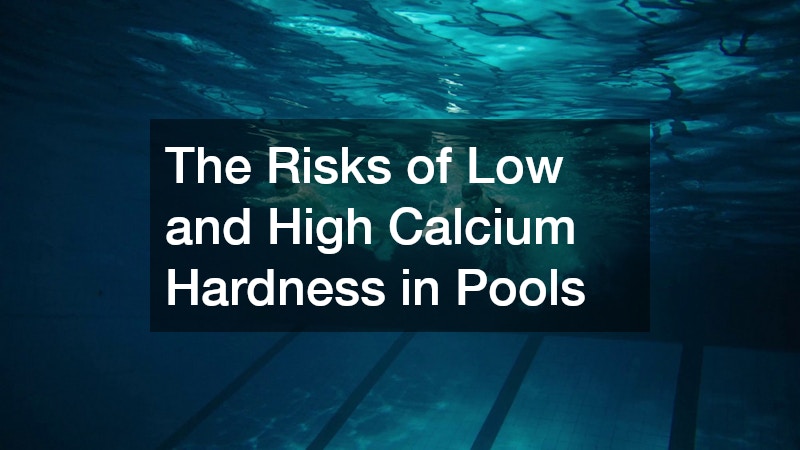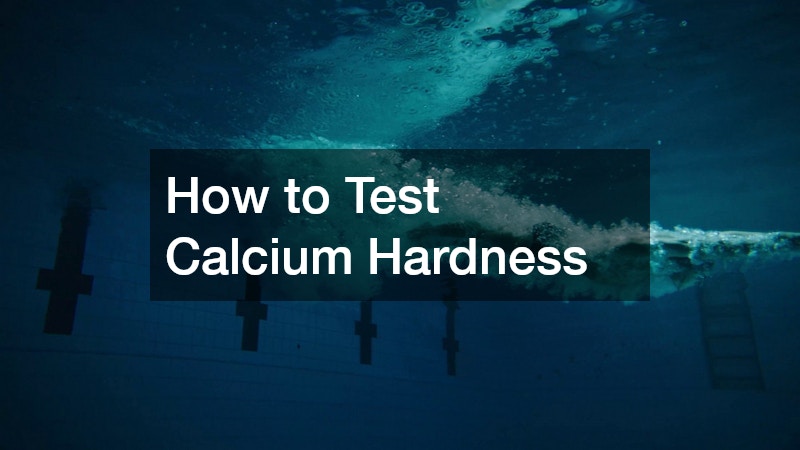
Maintaining proper water balance is essential for a healthy and safe swimming pool, and one of the most important, yet often overlooked, factors is calcium hardness. Calcium hardness refers to the concentration of calcium ions in pool water, measured in parts per million (ppm). Both low and high calcium levels can lead to serious problems, affecting your pool’s equipment, surfaces, and water quality. Understanding the risks of calcium imbalance and learning how to manage it is essential for every pool owner.
What Is Calcium Hardness?
Calcium is a naturally occurring mineral in water, and its concentration in your pool determines the water’s hardness. The ideal calcium hardness level typically ranges between 200 and 400 ppm, though this can vary depending on pool type, water source, and climate. Maintaining calcium within this range helps protect your pool surfaces and equipment while ensuring clear, safe water for swimming.
Risks of Low Calcium Hardness
When calcium hardness is too low, water becomes “soft”, meaning it lacks sufficient minerals to stabilize its balance. Low calcium hardness can cause a variety of problems:
1. Corrosion of Pool Surfaces and Equipment
Soft water is highly corrosive. It tends to pull calcium from surfaces such as plaster, concrete, and tiles, gradually eroding the pool’s interior. Additionally, low calcium water can corrode metal components, including pumps, heaters, ladders, and pool fittings. Over time, this can lead to costly repairs or premature replacement of pool equipment.
2. Etching of Plaster and Concrete Pools
Plaster or concrete pools are particularly vulnerable to low calcium levels. When water lacks calcium, it aggressively dissolves calcium from the plaster, resulting in surface etching, rough textures, and visible pitting. Not only does this affect aesthetics, but it also creates areas where algae and bacteria can thrive.
3. Increased Chemical Consumption
Soft water with low calcium hardness is more reactive and can destabilize other water chemistry elements, such as pH and alkalinity. This imbalance often requires higher chemical usage to maintain proper water quality, increasing maintenance costs and making pool care more complicated.
4. Cloudy Water and Unstable pH
Low calcium levels can make it difficult to maintain stable pH levels. Unstable water chemistry can lead to cloudy water, scaling problems later, and discomfort for swimmers, such as skin and eye irritation.
Tip: If you notice etching, corrosion, or difficulty maintaining pH, test calcium hardness immediately. Raising calcium levels with calcium chloride can restore balance and protect your pool.
Risks of High Calcium Hardness
On the other hand, excessively high calcium levels, often referred to as “hard water,” can create a completely different set of issues. High calcium hardness can be just as damaging as low levels if left unmanaged.
1. Scale Formation
High calcium water tends to deposit minerals as scale on pool surfaces, plumbing lines, and equipment. This white, crusty buildup can form on tiles, pumps, heaters, and filters, reducing efficiency and potentially causing blockages or overheating. Scale is particularly common in areas with naturally hard water or pools that rely on evaporative water top-ups.
2. Reduced Water Clarity
Excessive calcium hardness can cause cloudiness or a hazy appearance in pool water. Calcium particles can remain suspended, making the water appear murky even when properly sanitized. This affects the aesthetic appeal of your pool and may discourage swimming.
3. Clogged Filters and Equipment Damage
Scale deposits from high calcium water can accumulate inside pumps, heaters, and filters, reducing their efficiency and lifespan. Clogged equipment may require frequent cleaning or replacement, and severe scaling can result in costly repairs or system downtime.
4. Difficult Chemical Balancing
High calcium levels can make other chemical adjustments challenging. For instance, adding chlorine or acid to high-calcium water can sometimes lead to unintended reactions, such as calcium carbonate precipitation, further complicating water balance.
Tip: If your water tests show high calcium hardness, consider partial water replacement with softer water or using a sequestering agent to prevent scale formation and protect your pool equipment. This should help lower calcium hardness in pool systems.

How to Test Calcium Hardness
Regular testing is the key to preventing calcium-related problems. Use a reliable test kit or take water samples to a pool professional for analysis. Test at least once a month, or more frequently if you have plaster pools, high evaporation rates, or frequent water top-ups.
Recommended Testing Practices:
-
Before opening your pool: Check calcium hardness after filling with water.
-
During the swimming season: Test monthly or after heavy rainfall, which can dilute calcium levels.
-
After adding water: If you add municipal or bore water, test calcium hardness to ensure balance.
Maintaining accurate records of calcium levels can help you track trends and prevent issues before they become serious.
Maintaining Proper Calcium Hardness
Balancing calcium hardness involves either increasing or decreasing mineral levels in your pool water:
-
To raise calcium hardness: Use calcium chloride according to the manufacturer’s instructions. Add gradually while the pump circulates water to prevent localized scaling.
-
To lower calcium hardness in pool systems: Partial water replacement is often the most effective solution. In extreme cases, using chemical sequestrants can help prevent calcium precipitation until water can be replaced.
Additional Tips:
-
Maintain balanced pH and alkalinity, as calcium interacts closely with these parameters.
-
Regularly inspect pool surfaces, plumbing, and equipment for early signs of damage or scaling.
-
Consider professional pool maintenance for precise adjustments, especially in high-end pools with plaster or tile finishes.
Calcium hardness is a critical component of pool water chemistry, and both low and high levels pose significant risks. Low calcium hardness can corrode surfaces, damage equipment, and make chemical balancing difficult, while high calcium hardness leads to scale formation, cloudy water, and clogged equipment. Regular testing, monitoring, and adjustments are essential for maintaining a safe, attractive, and functional pool.



